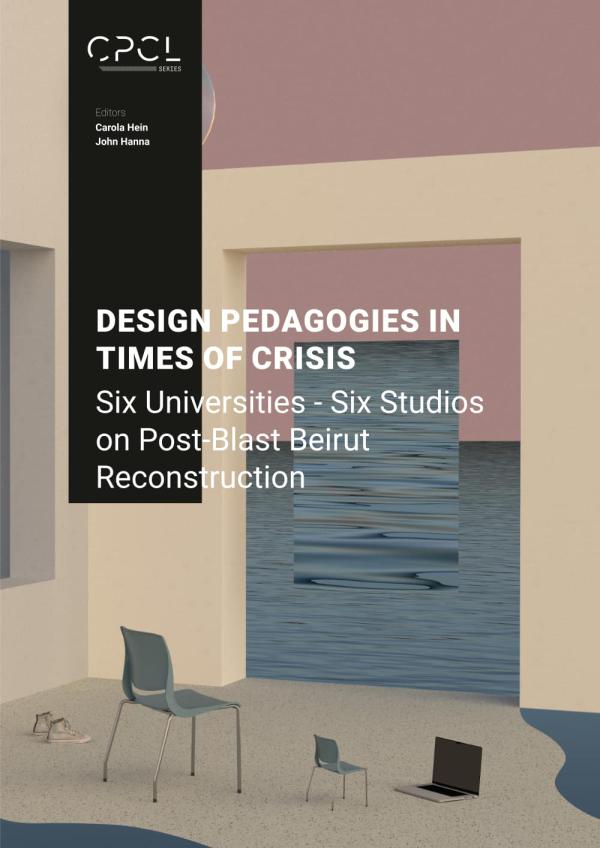Design Pedagogies in Times of Crisis
Six Universities - Six Studios on Post-Blast Beirut Reconstruction
Downloads

Synopsis
In the spring of 2021, professors and teachers from around the world taught studio courses and seminars that focused on the destruction and rebuilding of Beirut following the massive explosion that took place in the port on August 4, 2020. Some of these courses were taught collaboratively, others started as an independent project, but students and faculty attended each other’s presentations. Each studio was largely taught online due to the coronavirus crisis, which allowed for easier exchange among the groups. But it also prevented the studios from traveling to the field and closely surveying it. Faculty and students relied on presentations and input by colleagues from Beirut, material that could be found online, and documents that were available, mainly in English/French, which to a certain extent limited perspectives. Mutual interest in one another’s work led to some intriguing observations, including about pedagogical approaches and conceptual foundations. Each studio focused on specific premises, as the teachers chose diverse analytical viewpoints to address the rebuilding. At Delft University of Technology, teachers emphasized Beirut’s status as a port city and on the sea-land continuum as the analytical starting point for the design, and they collaborated with Yale University’s Alan Plattus ran a parallel seminar on the history of port cities. At the American University of Beirut (AUB), the instructors focused on the role of visionary planning for post-disaster rebuilding. In the University of Miami, neighborhood-level interventions inspired the teaching in Jean-François Lejeune upper-level spring studio. Similarly, in the German University in Cairo, Holger Gladys’s design studio focused on interventions at the neighborhood-level, namely the Karantina neighborhood, and its up-scalability to city and regional scales. At Tsinghua University, the design studio of Jian Liu and Yang Tang explored the multiple possibilities of rebuilding Beirut’s port and regenerating the city of Beirut on different scales by way of comprehensive urban design.
The different interventions proposed by the teachers and the different course assignments shaped the students’ analytical viewpoints and designs. Students took different positions and pursued different objectives. Conceptual differences and approaches to research seem to have mattered as much as the location of the studio, notably the proximity to or distance from Beirut. Teachers were inspired by their local school’s philosophy and research approaches. They also were guided by their personal connection to the disaster. The Beirut-based studio focused more on theoretical approaches and abstract implications, possibly an attempt to achieve some distance between the events and the planning. Yet the Beirut-based participants also showed a strong desire to add a memorial component to the design. So, while at first glance it may seem that the Beirut team wanted to keep distance from the disaster, the design response showed extensive knowledge and understanding of the local needs and conditions. Meanwhile the participants in other locations focused on aspects that spoke more strongly to international concerns; however, many of the teams also included teachers and students with advanced knowledge of Lebanon and Beirut, and they brought that expertise to the design.
The organization of the studios, the knowledge of teachers, and the production by students are explored in greater detail in this publication, raising a number of questions for further exploration. What this semester seems to have shown us is that both the form and approach to research and the set-up of teaching design studios have a strong impact on the outcomes, thus, there is a clear relationship between research and design. An explicit understanding of this relationship could help us rethink and refine studio teaching. Educational pedagogies in many fields have been carefully explored and studied; design education is a field that merits further exploration. This book aims to add to the theme of design education by presenting and collaboratively analyzing the six studios that focused on the rebuilding of the port city of Beirut following the 2020 disaster in terms of approach, methodology, teaching format, pedagogy, and more. While exploring the pedagogical aspects of these studios, the publication also considers the unique conditions of Beirut and Lebanon and the international exchange of architectural and planning ideas, including at a time of crisis.
To share the insights gained through our courses, this book is structured in three parts. The first part addresses educational approaches through the lens of teaching about time and concepts. It argues that an understanding of long-term development is relevant for informed future planning. It also argues that we need to understand the conceptual framework that we employ for research and teaching. The second part presents the case of Beirut and explores the syllabi, assignments, and projects developed in all of the participating institutions. The third part engages in a conversation with Beirut-based scholar and educator, Mona Harb, to provide a retrospective reflection on the international collaborations among studios and the lessons which could be learned from it.





